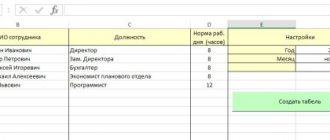The number of jobs is determined by the labor intensity of the assembly. For non-line production during detailed design, use the formula:
,
where Tsb is the complexity of assembling one product, man-hour;
N – annual production of products or components, pcs;
Fr.m – effective annual time fund of the workplace, hour;
Рсб – average work density.
Work density refers to the average number of workers per workplace.
Similar workplaces during a special assessment of working conditions
03.10.2017 9:46:00
Conducting a special assessment of working conditions (SOUT) begins with preparing a list of jobs to be assessed. This allows the employer to know the preliminary cost of the procedure. But due to misidentification of similar jobs, price calculations often end up being wrong.
Conducting a special assessment of working conditions (SOUT) begins with preparing a list of jobs to be assessed. This allows the employer to know the preliminary cost of the procedure. But due to misidentification of similar jobs, price calculations often end up being wrong.
HOW TO COUNT JOBS FOR SOUTH WITHOUT ERROR?
Federal Law No. 426-FZ defines signs of similarity, according to which workplaces are considered similar: those located in one or several monotype premises (work areas); equipped with monotype engineering systems (lighting, heating, ventilation); occupied by workers of the same profession, performing the same job duties in the same working mode, using the same devices and tools, raw materials and materials, provided with the same PPE. For example, the jobs of an accountant and a chief accountant will not be considered similar. Because, despite the fact that they work in the same workspace, their positions are called differently. The desire of employers to classify as many jobs as possible as similar is explained by the desire to minimize time and financial resources for carrying out special labor assessments. After all, only 20% of the total number of similar jobs (but not less than two) are necessarily assessed, for which a general SOUT map is drawn up and a unified list of actions to improve working conditions is prepared. For example, the staff of a call center includes five operators performing the same job duties in the same room. Of course, these are similar jobs. Since 20% of the total number is estimated, one workplace is subject to SOUT. But no, the law requires you to evaluate at least two jobs. Therefore, two jobs for the position “operator” must be included in the list for the SOUT. If an enterprise has two similar engineer jobs, they are both subject to a special assessment, which is required to ensure that the most objective results are obtained during instrumental measurements.
Example:
At the Uslada factory, 20 machinists work in workshop No. 1. All jobs are similar. That is, a special assessment of research (testing) and measurements are carried out in relation to 20%, i.e. at 5 similar places. If, based on the results of a special assessment, a harmful and (or) dangerous class of working conditions is established at these workplaces, then the corresponding class (subclass) of working conditions is established at all workplaces. For each worker, appropriate guarantees and compensation are assigned, and a list of measures to improve working conditions is developed. For all similar jobs, one special assessment card of working conditions will be filled out.
By the number of jobs and service standards.
Detection of discrepancies even in one indicator will result in an assessment of all jobs. The size of the employee’s rate does not affect the workplace with SOUT, which is equal to one for employment at 0.5 and 0.3 rates, two jobs - for employment at 2, 15 rates.
WHY ARE NOT ALL WORKPLACES WITH THE SAME EQUIPMENT CONSIDERED SIMILAR?
Equally equipped workplaces do not always mean identical production processes. For example, an economist, an accountant and a personnel officer work in the same room. All of them are provided with the same computers, but their places cannot be similar, since all positions are different. In addition, the equipment must completely match such parameters as make, model and even year of manufacture. The company's staff includes five drivers. One of them is assigned a 2011 Peugeot car, the second is a 2008 Kia, and the other three are Škoda 2012 cars. Employers consider such jobs to be similar and make a mistake. Only three jobs held by Škoda drivers will be similar. The other two drivers drive different brands of cars with different production dates. To successfully classify jobs, you should also prepare in advance information about the category of the vehicle and the type of fuel used.
WHEN WILL JOBS FOR THE SAME POSITIONS NOT BE RECOGNIZED AS SIMILAR?
Some jobs held by employees with the same positions cannot be considered similar. The staff may include five managers performing completely different functions. Therefore, when counting similar places under SOUT, it is necessary to clarify the units headed by these managers. Their workplace may be a public relations, sales or marketing department, each of which must be assessed separately.
Shift work is another aspect that complicates the calculation of similar jobs when conducting SOUT. 14 plant operators work in two shifts on the juice bottling line. The employer added three jobs to the SOUT list. But 7 operators work in one shift, therefore, in accordance with the signs of analogy, two workplaces are subject to assessment if the operators of the second shift work at the same workplaces and perform monotypic functions on the same equipment.
To correctly identify similar places, you should use the support of an expert organization that will conduct a special assessment. It will help you create a list taking into account all the nuances and distinctive features of similar jobs.
ANSWERS ON QUESTIONS
HOW TO EXPLAIN TO THE STAFF THE CHANGE IN THE CLASS OF WORKING CONDITIONS?
The organization of the education system carried out SOUT. Hazard class 3.1 was removed from the cleaner's workplace, which resulted in dissatisfaction among the staff. How to argue the legality of changing the class of working conditions from 3.1 to 2 for personnel? Employees must be informed of changes in working conditions upon signature. The legality of actions can be confirmed by familiarizing staff with the relevant regulatory documents. An improvement in working conditions, certified by the SOUT, gives the employer the right to cancel compensation previously awarded to cleaners.
ARE ADDITIONAL INSURANCE PREMIUMS PAID IF THE SPECIAL ASSESSMENT HAS ESTABLISHED HARMFUL WORKING CONDITIONS?
After carrying out the special safety assessment, a hazard class of 3.1 was established in workplaces for many positions (economist, personnel officer, etc.). Is there a need to make additional contributions to the Pension Fund or can we limit ourselves to eliminating lighting violations? Workplaces with working conditions class 3.1, according to Federal Law No. 212-FZ, require payment of additional insurance premiums of 2%. After eliminating the violations, an extraordinary special inspection is carried out. If its results confirm improvements, additional insurance premiums may be canceled.
HOW TO DETERMINE THE EFFECT OF HUMIDITY AND MOLD ON PERSONNEL HEALTH?
The company's museum, dedicated to mining, geology and speleology, is located underground in the exhaust workings of an active mine, the microclimate of which is characterized by natural high humidity and mold. The implementation of SOUT applies to the workplaces of the guide and accompanying person, but the special classifier does not include humidity and mold. Is it possible and legitimate to assess the harmfulness of these factors outside the framework of the SOUT? To determine the level of moisture and the nature of mold, you can use the services of an independent expert organization with its own accredited research laboratory. If the real negative impact of these factors on the health of staff is confirmed, the employer will have to organize medical examinations, as well as provide staff with special clothing and PPE.
THE MOST IMPORTANT THING ABOUT HOW TO COUNT JOBS FOR SOUTH
Similar workplaces include workplaces located in one or more monotype premises, where workers with the same positions and functions work. Mandatory special assessment covers 20% of similar jobs, but not less than two. Similar workplaces are equipped with the same equipment, down to the brand and year of manufacture. With a shift work schedule, it is permissible to conduct a special assessment only of workers of one shift.
Source of publication: 1sout.ru.
All publications
Filling out table 10 of form 4-FSS
Good afternoon From K+ Glavnaya Kniga Publishing House, 02/15/2016 HOW TO COMPLETE TABLE 10 OF THE CALCULATION ACCORDING TO FORM 4-FSS? Table 10 of the calculation according to Form 4-FSS is filled out on the basis of data (clauses 29.1, 29.2 of the Procedure for filling out Form 4-FSS): - a report on the special assessment (certification) of working conditions carried out in the organization; — medical books, reports and other documents issued based on the results of mandatory preliminary and periodic medical examinations of employees. All data in Table 10 is indicated as of January 1 of the reporting year. This means that Table 10 as part of Form 4-FSS for the first quarter, first half of the year, 9 months and this year will be filled out in the same way. Special assessments and medical examinations carried out this year are not reflected in Table 10. Organizations registered in the current year submit Table 10 with dashes (clause 2 of the Procedure for filling out Form 4-FSS). The remaining organizations fill out Table 10 as follows (clause 2, 29.1 of the Procedure for filling out form 4-FSS). Fill in field What must be indicated Line 1, column 3 The number of jobs in the organization for which a special assessment of working conditions should be carried out. This is the total number of jobs in the organization, except for the jobs of homeworkers and remote workers (Part 3 of Article 3 of Law N 426-FZ) Line 1, Column 4 The total number of jobs for which a special assessment (certification) was carried out. If it was not carried out, then “0” is entered. Line 1 of column 5 If, as a result of a special assessment (certification): - workplaces classified as 3rd class of harmful (hazardous) working conditions are identified, - the number of such workplaces; - no such jobs have been identified - dash. If a special assessment (certification) was not carried out - “0” Line 1, column 6 If, as a result of a special assessment (certification): - workplaces classified as 4th class of harmful (hazardous) working conditions were identified, - the number of such workplaces; - no such jobs have been identified - dash. If a special assessment (certification) was not carried out - “0” Line 2, column 7 Number of workers employed in work with harmful (hazardous) working conditions, for which preliminary and periodic medical examinations are required. If there are no such workers, a dash Line 2 of column 8 The number of workers employed in jobs with harmful (hazardous) working conditions who have undergone mandatory preliminary and periodic medical examinations. If there are no such employees, a dash
When will jobs for similar positions not be considered similar?
- Some jobs held by employees with the same positions cannot be considered similar.
- Shift work is another aspect that complicates the calculation of similar jobs when conducting SOUT.
The staff may include five managers performing completely different functions. Therefore, when counting similar places under SOUT, it is necessary to clarify the units headed by these managers. Their workplace may be a public relations, sales or marketing department, each of which must be assessed separately.
14 plant operators work in two shifts on the juice bottling line. The employer added three jobs to the SOUT list. But 7 operators work in one shift, therefore, in accordance with the signs of analogy, two workplaces are subject to assessment if the operators of the second shift work at the same workplaces and perform monotypic functions on the same equipment.
To correctly identify similar places, you should use the support of an expert organization that will conduct a special assessment. It will help you create a list taking into account all the nuances and distinctive features of similar jobs.









